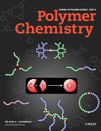Synthesis of multiarmed poly(3-hexyl thiophene) star polymer with microgel core by GRIM and ATRP methods
Abstract
Regioregular poly(3-hexyl thiophene) (rr-P3HT)-based star polymers were synthesized by a crosslinking reaction of the linear rr-P3HT macroinitiator and ethylene glycol dimethacrylate (EGDMA) crosslinker through Ru-based atom transfer radical polymerization (ATRP), where the rr-P3HT macroinitiator was prepared by Grignard metathesis method (GRIM) followed by end functionalization of the ATRP initiator with chlorophenylacetate (CPA) to the rr-P3HT. Relatively high molecular weight of the star polymers were obtained (Mp = 8,988,000 g/mol), which consisted of large numbers of the rr-P3HT arm chains radiating from the EGDMA-based microgel core. The yield of the star polymers were strongly affected by the added amount of the EGDMA crosslinker. The crystalline structure of the rr-P3HT by intermolecular π-π stacking interaction gradually decreased as the star polymer formed, which was confirmed by differential scanning calorimeter (DSC), atomic force microscopy (AFM), and electro-optical analyses. © 2011 Wiley Periodicals, Inc. J Polym Sci Part A: Polym Chem, 2011




